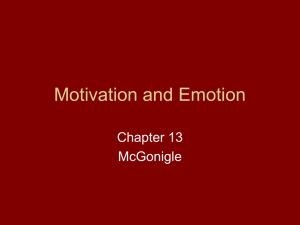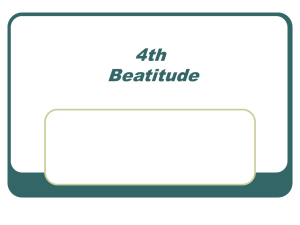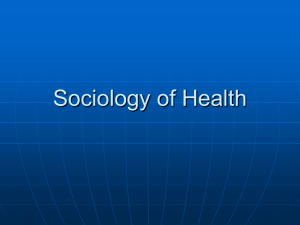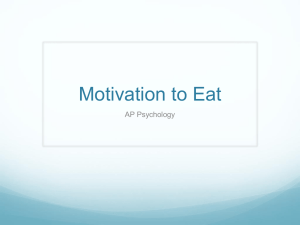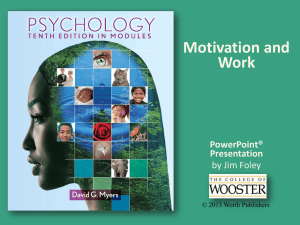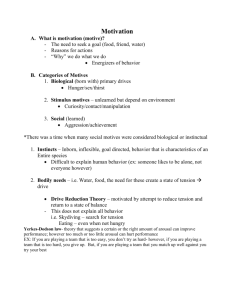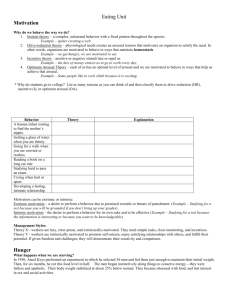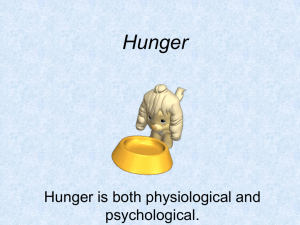Motivation takes many forms, but all involve inferred mental
advertisement
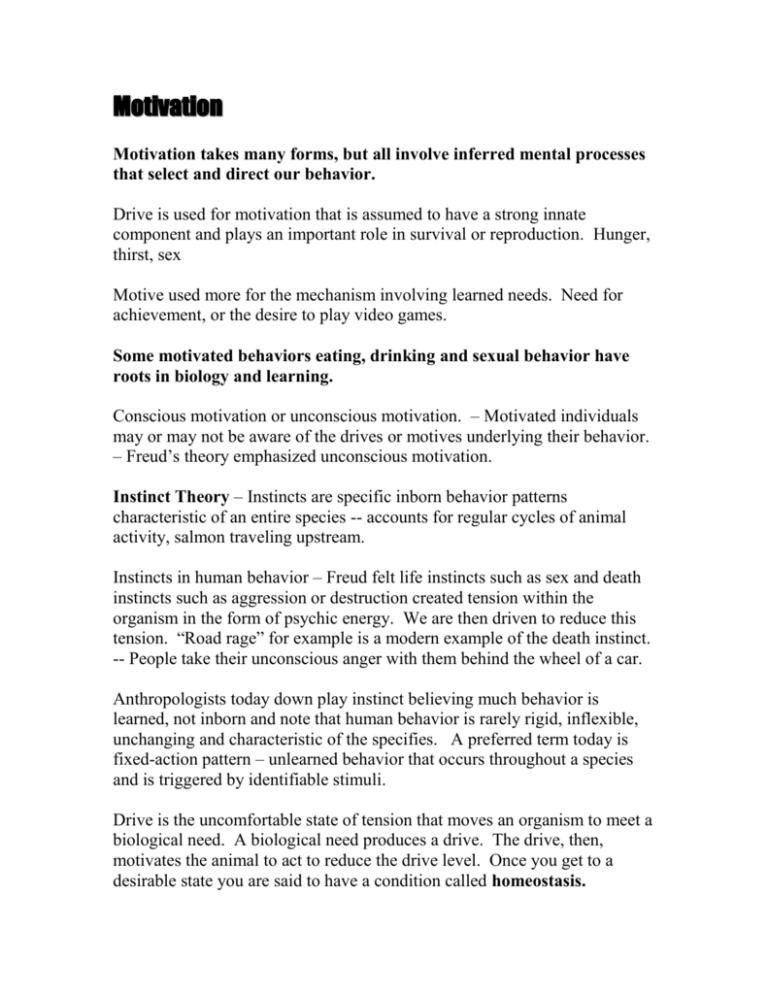
Motivation Motivation takes many forms, but all involve inferred mental processes that select and direct our behavior. Drive is used for motivation that is assumed to have a strong innate component and plays an important role in survival or reproduction. Hunger, thirst, sex Motive used more for the mechanism involving learned needs. Need for achievement, or the desire to play video games. Some motivated behaviors eating, drinking and sexual behavior have roots in biology and learning. Conscious motivation or unconscious motivation. – Motivated individuals may or may not be aware of the drives or motives underlying their behavior. – Freud’s theory emphasized unconscious motivation. Instinct Theory – Instincts are specific inborn behavior patterns characteristic of an entire species -- accounts for regular cycles of animal activity, salmon traveling upstream. Instincts in human behavior – Freud felt life instincts such as sex and death instincts such as aggression or destruction created tension within the organism in the form of psychic energy. We are then driven to reduce this tension. “Road rage” for example is a modern example of the death instinct. -- People take their unconscious anger with them behind the wheel of a car. Anthropologists today down play instinct believing much behavior is learned, not inborn and note that human behavior is rarely rigid, inflexible, unchanging and characteristic of the specifies. A preferred term today is fixed-action pattern – unlearned behavior that occurs throughout a species and is triggered by identifiable stimuli. Drive is the uncomfortable state of tension that moves an organism to meet a biological need. A biological need produces a drive. The drive, then, motivates the animal to act to reduce the drive level. Once you get to a desirable state you are said to have a condition called homeostasis. Homeostasis is the state of balance and stability in which the organism functions effectively. Drive reduction doesn’t explain all motivated behavior. Sometimes we seek activities that heighten tension or arousal. Both humans and other animals, in the absence of any apparent deprivation or drives, act merely to increase stimulation. Both engage in play – behavior that is satisfying in itself, rather than a means of reducing a drive. Animals explore and manipulate their environment simply for the sake of the experience. We jump out of planes, explore rather than eat sometimes. These activities are rewarding in themselves. Incentive theory: -- being aroused by external stimuli. (Being lured into a bakery by the aroma of bread fresh from the oven) In humans may be selfinduced by mental imagery. Picture your goal – can motivate you to study for a good grade – or motivate you to train for a gold medal. Can be induced by negative incentives, fear of feelings of shame for dropping out of a marathon race, fear of developing an addiction to drugs. Advertisers know that incentive stimuli (such as a commercial for tasty tacos) can activate a biological driver such as hunger. Cognitive theory and locus of control: Julian Rotter asserted that the likelihood of someone engaging in a given behavior (such as studying for an exam instead of partying) is determined by two factors: 1. One’s expectation of attaining a goal follow that activity 2. The personal value of that goal. Our expectations depend largely on our locus of control – our belief about our ability to control things that happen to us. If you believe that studying hard will lead to good grades, you have an internal locus of control – and you will behave differently from those who believe that grades depend of luck or the teacher’s biases. People who believe that their fate hangs on whim or luck have an external locus of control. Intrinsic vs. extrinsic motivation: One gets more pleasure and happiness from intrinsic activates. External rewards cause decreased emotional involvement and negative feelings. Higher intrinsic motivation is linked to higher school achievement and psychological adjustment in individuals. Primary Drives: Biological needs that trigger a corresponding state of psychological arousal. Unlearned drives are hunger, thirst and sex—common to all animals including humans. They are strongly influenced by stimulus within the body that is part of our biological programming for survival. Hunger: a psychological state of hunger is different from the biological need for food. Two centers in the brain are important in the hunger response: 1. The hunger center stimulates eating 2. The satiety center reduces the feeling of hunger. Both are located in the hypothalamus. It is believed that the brain monitors the level of glucose in the blood. A fall in the glucose level stimulates neurons in the hunger center. The brain also monitors fatty acids (acids from fat) and amino acids (acids from protein) The hormones that the brain monitors include cholecystokinin (CCK) insulin and leptin. When glucose levels rise, the pancreas releases insulin, a hormone that most body cells need in order to use the glucose they receive. Insulin may provide a satiety signal. Recently researchers have identified a mechanism in the brain that may be responsible for obesity. The theory states that fat cells produce a hormone called leptin, which travels in the bloodstream and is sensed by the hypothalamus. High levels of leptin signal the brain to reduced appetite, or to increase the rate at which fat is burned. Research with mice suggests that a defective gene may fail to regulate the level of leptin in the brain and be partly responsible for obesity. Replacing this hormone in obese animals results in a rapid loss of body fat. Receptors in the stomach know how much food the stomach is holding and how many calories that food contains. These receptors signal the satiety center and make us feel less hungry. Three regions of the hypothalamus play primary roles in detecting and reacting to the blood’s signals about the need to eat. Three areas are: Ventromedial nucleus “stop eating center”– activity fibers passing through here tells an animal there is no need to eat. If a rat’s ventromedial nucleus is electrically or chemically stimulated, the animal will stop eating. If it is destroyed the animal will eat ravenously, increasing its weight up to three fold. Lateral hypothalamus: “start eating center”: When electrically stimulated rats begin to eat vast quantities even if they have just had a large meal. When it is destroyed rats stop eating almost entirely. One theory maintains that these two regions interact so as to maintain a set point of body weight, food intake, or related metabolic signals much as a thermostat turns off and on in order to maintain a preferred temperature. Paraventricular nucleus (PVN) suggests more complexity than just stop eating and start eating centers. Hunger for different types of food seems to be related to the action of different neurotransmitters on PVN neurons. Neuropeptide Y stimulates carbohydrate eating Serotonin acts to reduced carbohydrate consumption Galanin motivate eating of high fat food, Enterostation reduces fat consumption. Why do few animals except humans become overweight? There are also external cues that may trigger the desire to eat. Smells, times, situations. Emotions may affect the hunger drive. Angry, bored, nervous, upset. Social influences also affect our motivation to eat – to be nice or to not look like a “pig”. Thirst is stimulated by both internal and external cues. Two regulators interact and complement each other. One monitors the level of fluids inside the cells of the body, activating the thirst drive when cells become dehydrated. The other thirst regulator monitors the amount of fluid outside the cells. When the level of extra cellular fluid drops less blood flows to the kidneys, which in turn releases a substance into the bloodstream that triggers the thirst drive. Eating Disorders: symptoms of anorexia nervosa 1% suffer 90% of those are white middle class females, who have had a normal childhood land adolescents. Successful, cooperative, well behaved. Bulimia: criteria of more have this 4-8% of all adolescent feels and 2% males. Often starts as a result of facing new life situations. Also from upper socioeconomic groups, commonly have lower self-esteem and often depression. Feelings of vulnerability and helplessness. Sex: the primary drive that motivates reproductive behavior. It can be turned on and off by biological conditions in the body and by environmental cues. Vital to the survival of the species. Masters and Johnson first to study sex as a science. Human Sexual Response is famous book. Once it was thought that fluctuations in the level of hormones like testosterone determined sex drive. Today we know it is more complex. Moment to moment fluctuations in testosterone are not necessarily linked to the sex drive. Pheromone secretion may influence human sexual attraction as it does in other animals. Early stages of excitement and arousal are more dependent in humans on experience and learning than on biology. Men and women are aroused in different ways. Men –visual cues, women touch. Men seem to get more pleasure from sex than women – and think about it more often! Sexual Orientation: -- the direction of an individual’s sexual interest. Some surveys indicate that 10% of the population was homosexual. More recent statistics indicate about 2.8% of males and 1.4% of females. The cause of orientation is a classic nature/nurture debate. Stimulus Motives: Are largely unlearned, external stimuli –associated with obtaining information about the environment? Exploration and curiosity: James felt it was an emotion; Freud felt it a socially acceptable expression of the sex drive! Not correlated to intelligence but perhaps to creativity. The more we explore the more we are motivated to explore! Manipulation and contact: we have great urges to touch- only primates to this because of agile fingers and toes. Also want to touch other people. Contact is more universal than manipulation. Know Harlow’s monkey experiment – very important. Aggression: refers to behavior that is intended to inflict physical or psychological harm on others. Some fee it is a vestige of our evolutionary past triggered by pain or frustration. (Rat experiment) Frustration does not always produce aggression. Some withdraw, some escape into drugs or alcohol. Frustration seems to generate aggression only in people who have learned to be aggressive as a means of coping with unpleasant situations. Freud says it as an innate drive that builds up until it is released. He felt it needed to be channeling into socially acceptable avenues, sports, and other forms of competition. Yet engaging in aggressive behavior does not always dissipate anger, sometimes it makes it worse. Most people agree that there is no innate aggressive drive – human aggression is largely a learned response. Remember Bandura’s experiment. Cultures vary in how they handle aggression. Some cultures are quite peaceful. The difference seems to point to whether the culture is a collectivist society or and individualist one. Gender and aggression – males more likely than females. Is it biological or social in origin? -- Testosterone evidence, evolution, social factors. Achievement There is separate achievement motive. It has been studied through the TAT and WOFO scale. Students with the highest grades were those who had high work and mastery scores, but low competitiveness scores. The belief is that highly competitive people alienate those who might help them achieve their goals, or preoccupation with winning distracts them from taking the actions necessary to attain their goals.

